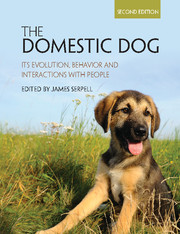Book contents
- Frontmatter
- Dedication
- Contents
- List of contributors
- 1 Introduction
- PART I ORIGINS AND EVOLUTION
- PART II BEHAVIOR, COGNITION AND TRAINING
- 5 Genetics of dog behavior
- 6 Becoming a dog: Early experience and the development of behavior
- 7 Breed and gender differences in dog behavior
- 8 Dog social behavior and communication
- 9 Ethology, ecology and epidemiology of canine aggression
- 10 Social cognition and emotions underlying dog behavior
- 11 The learning dog: A discussion of training methods
- 12 Dogs in today's society: The role of applied animal behavior
- PART III DOG-HUMAN INTERACTIONS
- PART IV LIFE ON THE MARGINS
- Index
- Plate section
- References
6 - Becoming a dog: Early experience and the development of behavior
from PART II - BEHAVIOR, COGNITION AND TRAINING
Published online by Cambridge University Press: 30 December 2016
- Frontmatter
- Dedication
- Contents
- List of contributors
- 1 Introduction
- PART I ORIGINS AND EVOLUTION
- PART II BEHAVIOR, COGNITION AND TRAINING
- 5 Genetics of dog behavior
- 6 Becoming a dog: Early experience and the development of behavior
- 7 Breed and gender differences in dog behavior
- 8 Dog social behavior and communication
- 9 Ethology, ecology and epidemiology of canine aggression
- 10 Social cognition and emotions underlying dog behavior
- 11 The learning dog: A discussion of training methods
- 12 Dogs in today's society: The role of applied animal behavior
- PART III DOG-HUMAN INTERACTIONS
- PART IV LIFE ON THE MARGINS
- Index
- Plate section
- References
Summary
Introduction
Early life experiences are known to have more profound and persistent effects on behavioral development than those occurring at other stages of the life cycle (see Bale et al., 2010; Bateson, 1981; Crews, 2011; Levine, 1962; Simmel & Baker, 1980). Pioneering studies of the domestic dog have contributed significantly to our current understanding of these effects of early experience. In 1945 an extensive program of research was initiated at the Roscoe B. Jackson Memorial Laboratory at Bar Harbor, Maine, on the relationship between heredity and social behavior in dogs. This work, which included detailed descriptive and experimental studies of behavioral genetics and ontogeny, led to the conclusion that there are particular “critical” periods in early development when puppies are unusually sensitive to environmental influences and, therefore, especially susceptible to the effects of early experience (see Elliot & Scott, 1961; Freedman et al., 1961; Fuller, 1967; Scott, 1962, 1963; Scott & Fuller, 1965; Scott & Marston, 1950; Scott et al., 1974).
In the last 10–15 years, the emerging field of behavioral epigenetics has revolutionized our understanding of the ways in which genes and experience – nature and nurture – interact during development to produce such effects. It is now known, for example, that a wide variety of environmental factors, including maternal behavior, physical and emotional stress, and exposure to toxins, drugs and hormones – especially during the early part of life – can modify the expression of the genes that regulate the central nervous system without altering the DNA sequence. This essentially means that, while the genome still provides the design blueprint for the developing brain and nervous system, it is an adjustable blueprint that can respond dynamically to information and experience coming from the environment, and thereby alter the course of behavioral development in adaptive ways (Bale et al., 2010; Berger et al., 2009; Cardoso et al., 2015; Heim & Binder, 2012; Sweatt, 2013; van den Berg, Chapter 5). Furthermore, at least some of these changes in gene expression appear to be heritable in the sense that they can be propagated, either through germ cells or via the quality of parental behavior, to affect later generations (Crews, 2011; Curley et al., 2011a, 2011b; Dunn et al., 2011; Lynch & Kemp, 2014; Patchev et al., 2014).
- Type
- Chapter
- Information
- The Domestic DogIts Evolution, Behavior and Interactions with People, pp. 93 - 117Publisher: Cambridge University PressPrint publication year: 2016
References
- 13
- Cited by



